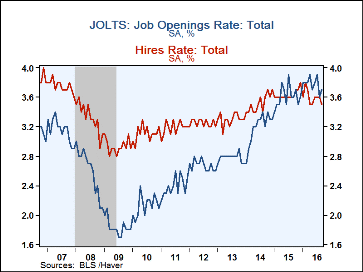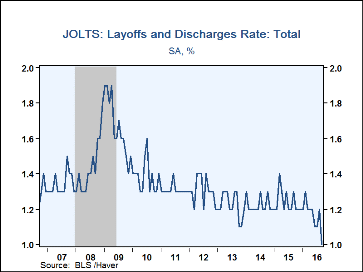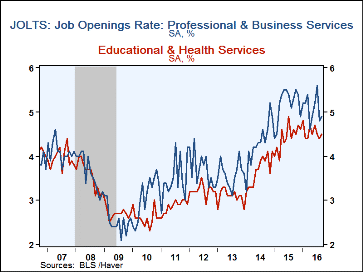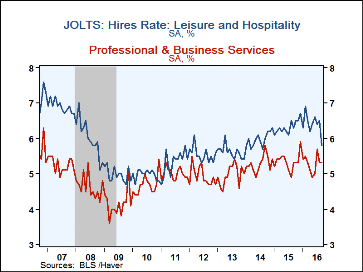 Global| Nov 08 2016
Global| Nov 08 2016U.S. JOLTS: Job Openings Improve While Layoffs Decline Sharply
by:Tom Moeller
|in:Economy in Brief
Summary
The labor market improved further during September. The total job openings rate increased to 3.7% from an unrevised to 3.6% in August. It remained down. however, from the record high of 3.9% in July. The private sector job openings [...]
The labor market improved further during September. The total job openings rate increased to 3.7% from an unrevised to 3.6% in August. It remained down. however, from the record high of 3.9% in July. The private sector job openings rate held steady at 3.9%, a three month low. In the government sector, the job openings rate fell sharply to 2.2%, the lowest point since March versus an upwardly revised 2.3%. The Bureau of Labor Statistics reports these figures in its Job Openings & Labor Turnover Survey (JOLTS).
The job openings rate increased in most major sectors of the labor market. In construction, it rose sharply to 3.2%, double the rate twelve months earlier. The professional & business services job openings rate improved slightly to 4.9%, but remained lower than the 5.6% July high. The education & health services rate also improved slightly to 4.5%. The leisure & hospitality rate plunged, however, to 4.3%, the lowest level since December 2014. The factory sector job openings rate ticked up to 2.7%. The job openings rate is the number of job openings on the last business day of the month as a percent of total employment plus job openings.
The actual number of job openings improved a slight 0.6% (2.4% y/y) to 5.486 million following a 6.5% decline in August. Private-sector openings gained 0.9% (2.2`% y/y) to 4.987 million, but remained the lowest level this year. Construction job openings more than doubled y/y, while the number of factory sector openings gained 7.1% y/y. On the weak side, professional & business services openings fell 5.0% y/y while leisure & hospitality openings eased 0.7% y/y, down 6.4% versus August. Education & health services openings fell 1.6% y/y. Government sector job openings increased 4.0% y/y, but have fallen sharply in the last two months.
The layoff and discharge rate set a record low of 1.0% in September, down from 1.3% twelve months earlier. The private sector rate plummeted to a new low of 1.1%, while the government sector rate eased to 0.5%. Total layoffs declined 20.0% y/y. Private-sector layoffs fell 21.1% y/y, while government layoffs eased 2.8% y/y.
The total hires rate eased to 3.5%, and remained down from February's high of 3.8%. The private sector hiring rate fell to 3.8%, and remained below the high of 4.2% reached in February. The hiring rate in leisure & hospitality fell sharply to 5.8%, its lowest level since August 2014. In education and health services, the hires rate pulled back to 2.6% from 3.0% last November. The hiring rate in professional and business services was stable at 5.3%, and it was unchanged in manufacturing at 2.2%. The hires rate in construction fell to 4.6%. To the upside, a 4.8% hires rate in retail trade was up from 4.5% three months earlier. The government sector hiring rate eased to 1.6%, but was up from 1.0% early in 2011. The hires rate is the number of hires during the month divided by employment.
The number of hires declined 3.5% (-1.0% y/y) to 5.081 million in September. It was the lowest level since May. Private sector hiring fell 3.5% (-1.9% y/y) as jobs in leisure & hospitality declined 9.7% (-5.5% y/y). Construction employment fell 8.0% (-4.3% y/y) while factory sector hiring declined 1.8% (-3.6% y/y). Professional & business services improved 0.5% (1.8% y/y) and jobs in retail trade experienced a 2.5% increase (3.6% y/y). Government sector hiring declined 3.9% (+12.3% y/y).
The total job separations rate eased to 3.4%, down from its cycle high of 3.6% in February. The actual number of separations fell 2.7% m/m (-0.8% y/y) to 4.914 million. Retail trade separations eased 0.6% y/y while leisure & hospitality separations dropped 1.4% y/y. Professional and business services eased 0.3% y/y while separations in the education and health services sector increased 2.4% y/y. Government separations increased 12.1% y/y. Separations include quits, layoffs, discharges, and other separations as well as retirements.
Large numbers of hires and separations occur every month throughout the business cycle. Net employment change results from the relationship between hires and separations. When the number of hires exceeds the number of separations, employment rises, even if the hires level is steady or declining. Conversely, when the number of hires is less than the number of separations, employment declines, even if the hires level is steady or rising. Over the 12 months ending in July, hires totaled 62.5 million and separations totaled 60.0 million, yielding a net employment gain of 2.5 million. These totals include workers who may have been hired and separated more than once during the year.
The JOLTS survey dates to December 2000 and the figures are available in Haver's USECON database.
| JOLTS (Job Openings & Labor Turnover Survey, SA) | Sep | Aug | Jul | Sep '15 | 2015 | 2014 | 2013 |
|---|---|---|---|---|---|---|---|
| Job Openings, Total | |||||||
| Rate (%) | 3.7 | 3.6 | 3.9 | 3.6 | 3.6 | 3.3 | 2.7 |
| Total (000s) | 5,486 | 5,453 | 5,831 | 2.4% | 9.7% | 28.7% | 4.6% |
| Hires, Total | |||||||
| Rate (%) | 3.5 | 3.6 | 3.6 | 3.6 | 43.6 | 42.2 | 39.6 |
| Total (000s) | 5,081 | 5,268 | 5,258 | -1.0% | 5.2% | 8.2% | 3.5% |
| Layoffs & Discharges, Total | |||||||
| Rate (%) | 1.0 | 1.2 | 1.1 | 1.2 | 14.9 | 14.7 | 14.7 |
| Total (000s) | 1,474 | 1,692 | 1,639 | -20.0% | 2.7% | 2.4% | -5.3% |
Tom Moeller
AuthorMore in Author Profile »Prior to joining Haver Analytics in 2000, Mr. Moeller worked as the Economist at Chancellor Capital Management from 1985 to 1999. There, he developed comprehensive economic forecasts and interpreted economic data for equity and fixed income portfolio managers. Also at Chancellor, Mr. Moeller worked as an equity analyst and was responsible for researching and rating companies in the economically sensitive automobile and housing industries for investment in Chancellor’s equity portfolio. Prior to joining Chancellor, Mr. Moeller was an Economist at Citibank from 1979 to 1984. He also analyzed pricing behavior in the metals industry for the Council on Wage and Price Stability in Washington, D.C. In 1999, Mr. Moeller received the award for most accurate forecast from the Forecasters' Club of New York. From 1990 to 1992 he was President of the New York Association for Business Economists. Mr. Moeller earned an M.B.A. in Finance from Fordham University, where he graduated in 1987. He holds a Bachelor of Arts in Economics from George Washington University.










